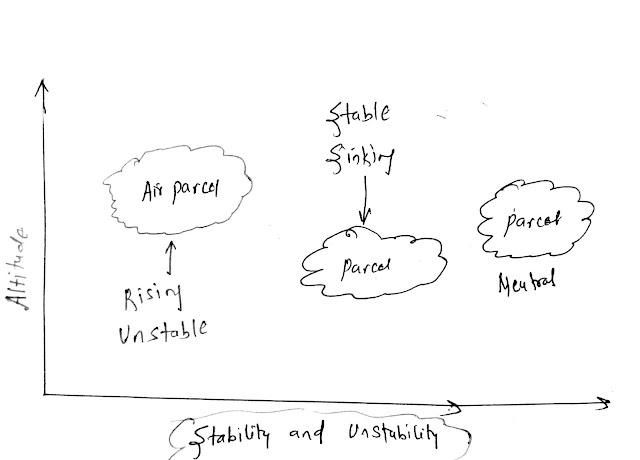Table of Contents
- Atmospheric stability and instability
- Reasons for atmospheric stability or Instability.
- How do we know whether air parcel is stable or unstable?
- Normal Lapse Rate
- Adiabatic Lapse Rate
- The dry adiabatic lapse rate
- The moist adiabatic lapse rate
- Atmospheric stability
- Absolute stability
- Atmospheric instability
- Conditional Instability
- Absolute instability or Mechanical Instability
- Distribution of atmospheric instability and instability
Atmospheric stability and instability:
The following diagram shows the stability and Instability of the atmosphere.
- A rising and sinking air parcel is generally unstable
- Stationary air parcels are usually stable
Reasons for atmospheric stability or Instability:
There are two reasons for atmospheric instability:
- Thermal: due to insolation and convection.
- Air rises or sinks, both create instability.
- Dynamic due to earth rotation:
- In 60 and 65 degrees latitude, air rises, and 30 to 35 degrees latitude, air sinks.
- In the case of thermal inversion, there is an extremely stable situation.
How do we know whether the air parcel is stable or unstable?
By finding the following lapse rate
- Normal lapse rate
- Adiabatic lapse rate
- Dry Adiabatic Lapse rate
- Wet Adiabatic Lapse rate
Rate of temperature decrease with height in a stable atmosphere. It is usually 6-degree centigrade per km.
Adiabatic:
- A process where air parcel temperature changes due to expansion or compression, no heat is added or taken out from air parcel.
Adiabatic lapse rate:
Dry Adiabatic Lapse rate:
Moist adiabatic lapse rate:
- The rate of temperature changes that happen with the rising air parcel is called the adiabatic lapse rate.
Dry Adiabatic Lapse rate:
- The rate of temperature decrease of the rising dry air parcel, it is usually 8 degrees centigrade per km.
- Dry condensed less when going up and latent heat of evaporation is less compared to normal lapse rate, hence temperature decrease is more with altitude.
Moist adiabatic lapse rate:
- The rate of temperature decrease of the rising humid air parcel, it is usually 4 degrees centigrade per km. The latent heat of evaporation is released more when air goes up, hence temperature decrease is less of rising air and creates instability.
The following are short terms for finding stability and instability:
- Air parcel that we want to find out the stability and instability; we will say Environment Lapse Rate (ELR).
- Dry Adiabatic Lapse rate( DALR)
- Humid Adiabatic Lapse rate( HALR)
Stable air Parcel
Air parcel does not rise and rain being clouded does not form.- In the case of temperature inversion, the environment air parcel will be stable.
- If ELR > DALR; then the air parcel will be absolutely stable.
Conditional instability:.
If HALR < ELR < DALR; this condition is called conditional instability, it may be stable or sometimes unstable.
If HALR < ELR < DALR; this condition is called conditional instability, it may be stable or sometimes unstable.
Absolute instability:
If ELR< HALR; then the air parcel will be absolutely unstable.
If ELR< HALR; then the air parcel will be absolutely unstable.
Absolute instability is also called Mechanical instability. It is found in the equatorial region.
Distribution of atmospheric instability and instability:
The following are distributions:- All the 7 atmospheric pressure belt are unstable region, that is:
- Low atmospheric pressure belt(1nos)
- Subtropical high-pressure belt in both hemisphere (2 nos)
- Subpolar low-pressure belt in both hemisphere ( 2nos)
- Polar high-pressure belt ( 2 nos)
- Boundary lines of all the airmasses.
- Air masses that are found in between pressure belts are a stable region.




ConversionConversion EmoticonEmoticon